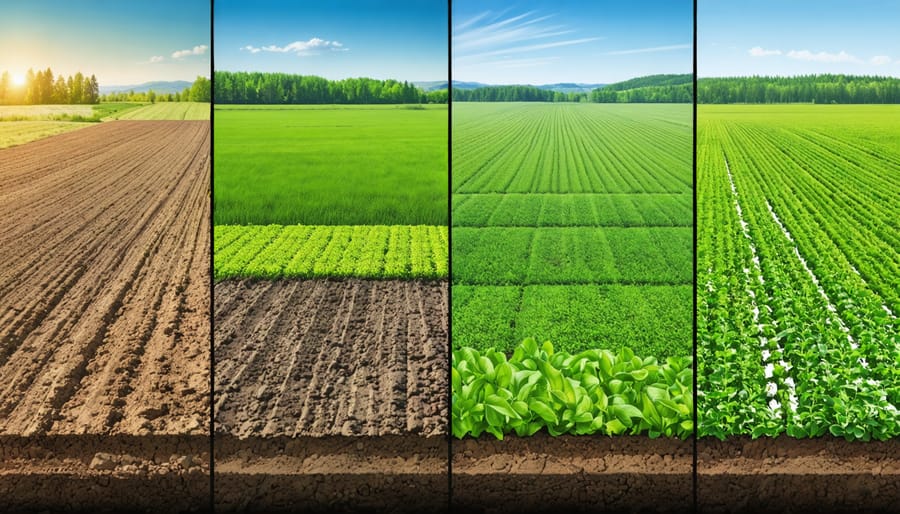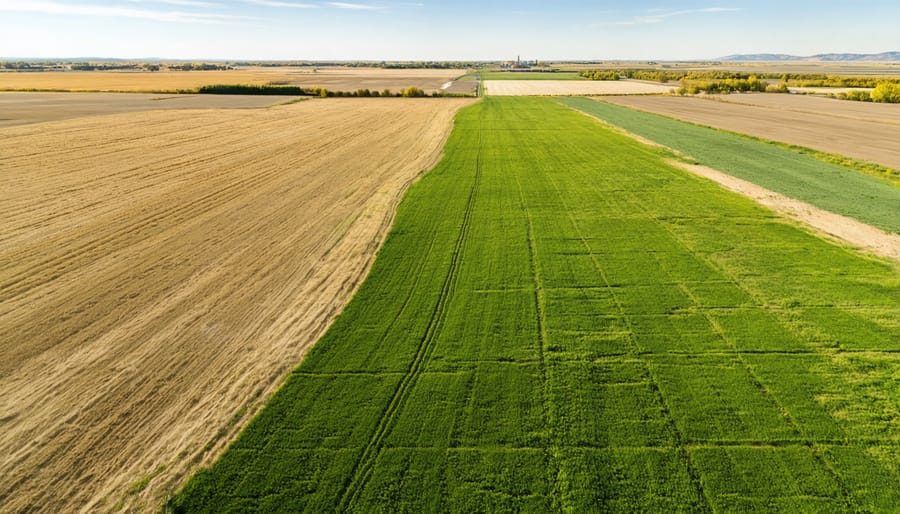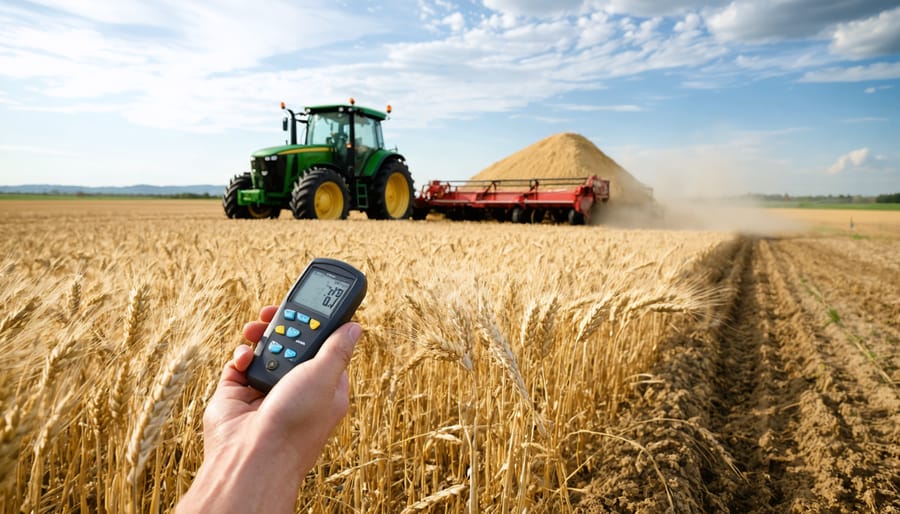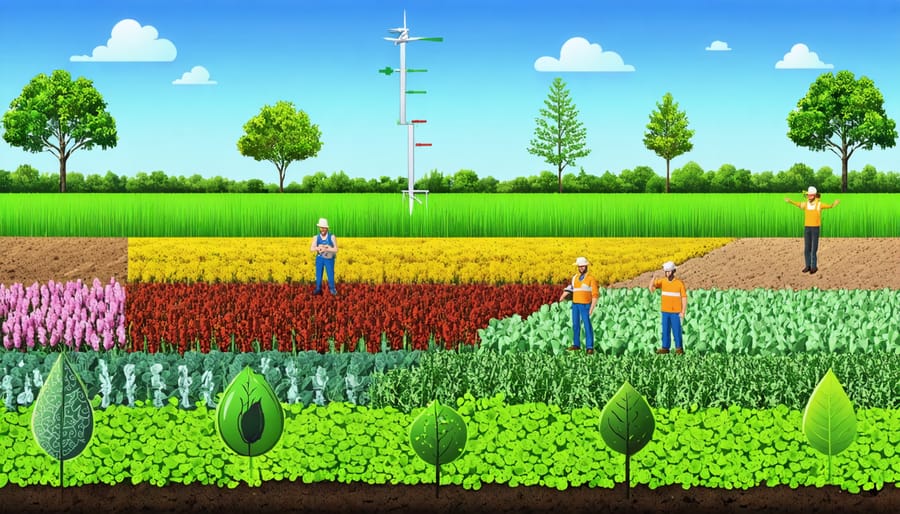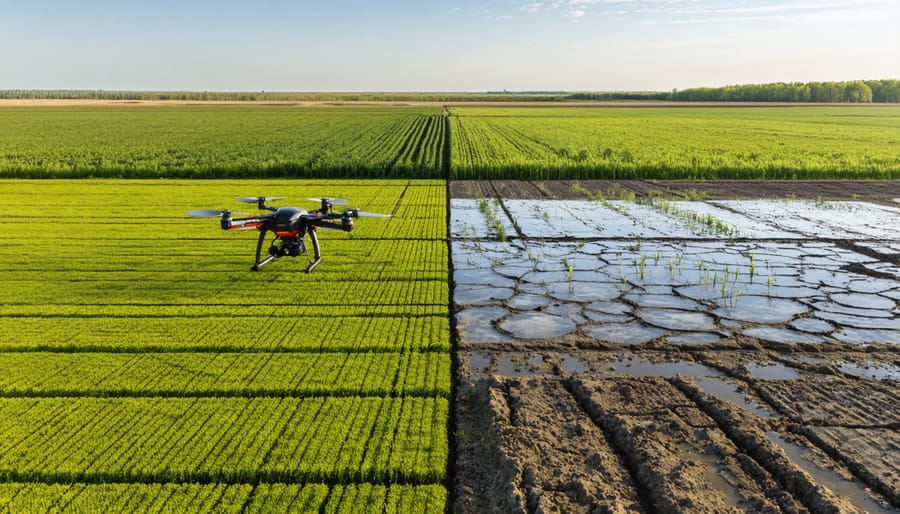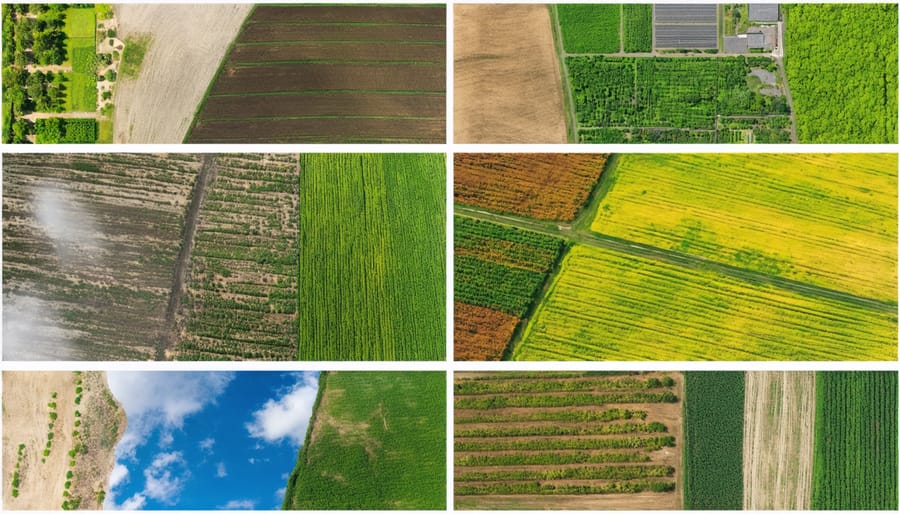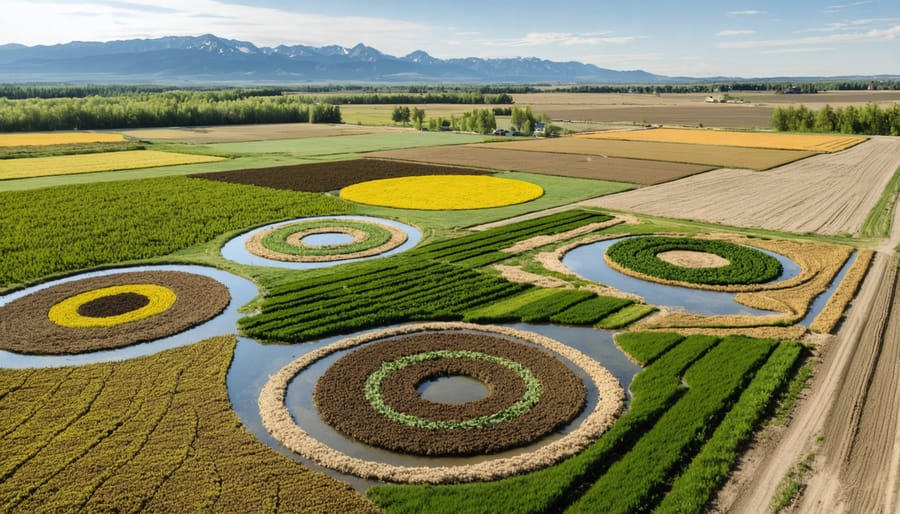Carbon sequestration stands as one of our most promising tools in the fight against climate change, particularly across Alberta’s vast agricultural landscape. Through carbon farming practices, Canadian farmers are transforming their fields into powerful carbon sinks while enhancing soil productivity. This natural process of capturing and storing atmospheric carbon dioxide in soil organic matter offers a rare win-win solution: it combats global warming while improving agricultural yields and soil health.
Recent studies from the University of Alberta demonstrate that properly managed farmland can sequester up to 2 tonnes of carbon per hectare annually, equivalent to taking one car off the road for a year. With Alberta’s 50 million acres of farmland, the potential impact is substantial. More importantly, carbon sequestration practices like no-till farming, cover cropping, and rotational grazing are proving economically beneficial, with participating farmers reporting up to 15% increases in crop yields and significant reductions in input costs.
As climate change intensifies and carbon markets mature, understanding and implementing effective carbon sequestration strategies has never been more critical for Canadian agricultural communities.
The Science Behind Soil Carbon Storage in Alberta
Alberta’s Soil Types and Their Carbon Storage Potential
Alberta’s diverse soil types offer varying potential for carbon storage, with our rich black Chernozemic soils leading the way in sequestration capacity. These soils, common in central Alberta’s parkland regions, can store up to 100 tonnes of carbon per hectare in their top layer alone. Our Dark Brown soils, found in the southern farming regions, also show impressive storage potential, typically holding 60-80 tonnes per hectare.
The province’s Brown soils, characteristic of our semi-arid southeastern regions, have slightly lower but still significant storage capacity. While they naturally store less carbon, these soils often have the most room for improvement through proper management practices.
Notably, our unique Solonetzic soils, covering about 4.5 million hectares of Alberta farmland, present special opportunities. Though challenging to farm, these soils can be transformed into excellent carbon sinks when managed with appropriate techniques like deep tillage and organic matter addition.
Our Luvisolic soils, common in northern agricultural areas, have good storage potential but require careful management to maintain organic matter levels and prevent erosion. Understanding your soil type is the first step in maximizing its carbon storage potential.
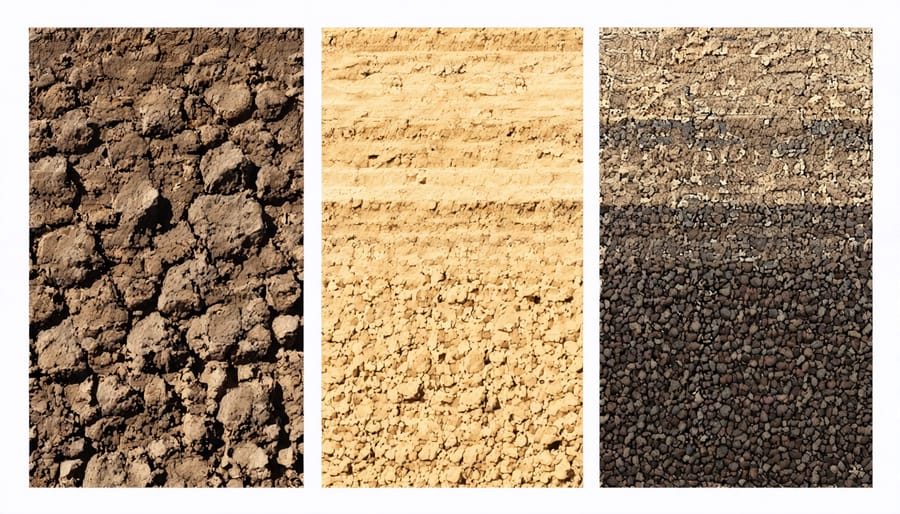
Environmental Factors Affecting Carbon Storage
Alberta’s unique climate and environmental conditions play a crucial role in how effectively our soils can store carbon. Our cold winters actually help preserve organic matter in the soil, as lower temperatures slow down decomposition rates. However, our relatively short growing season means we need to make the most of active periods for carbon capture.
Moisture levels significantly impact carbon storage potential across our province. Southern Alberta’s semi-arid conditions can limit organic matter accumulation, while central and northern regions often benefit from higher rainfall patterns that support better carbon sequestration. Soil texture also varies considerably – our prairie soils typically have good structure for carbon storage, but sandy soils may need extra attention to build organic matter.
Wind erosion, particularly in open prairie areas, can affect topsoil retention and carbon storage. That’s why many Alberta farmers have found success combining carbon sequestration practices with erosion control methods. The freeze-thaw cycles we experience can also influence soil structure and organic matter retention, making it important to maintain good ground cover throughout the year.
Understanding these local conditions helps us adapt our carbon storage practices for maximum effectiveness in our unique Alberta environment.
Proven Carbon Sequestration Methods for Alberta Farms
No-Till Agriculture
No-till agriculture has emerged as a cornerstone practice for carbon sequestration in Alberta’s farmlands. By minimizing soil disturbance, farmers can maintain vital soil structure and preserve organic matter, leading to significant no-till farming benefits for both the environment and crop yields.
Studies from Alberta’s agricultural research stations show that no-till practices can sequester up to 0.6 tonnes of carbon per hectare annually. This approach keeps crop residue on the soil surface, protecting it from erosion while gradually breaking down to enrich the soil with organic matter.
Implementation involves leaving crop stubble in place after harvest and using specialized seeding equipment that minimizes soil disturbance. Many Alberta farmers have successfully transitioned by starting with a single field and gradually expanding the practice across their operations.
Beyond carbon storage, no-till farming reduces fuel costs by eliminating multiple tillage passes, improves soil moisture retention, and enhances soil biodiversity. Local success stories, like the Brown family farm near Red Deer, demonstrate how no-till practices have improved soil health while maintaining profitable crop production over the past decade.
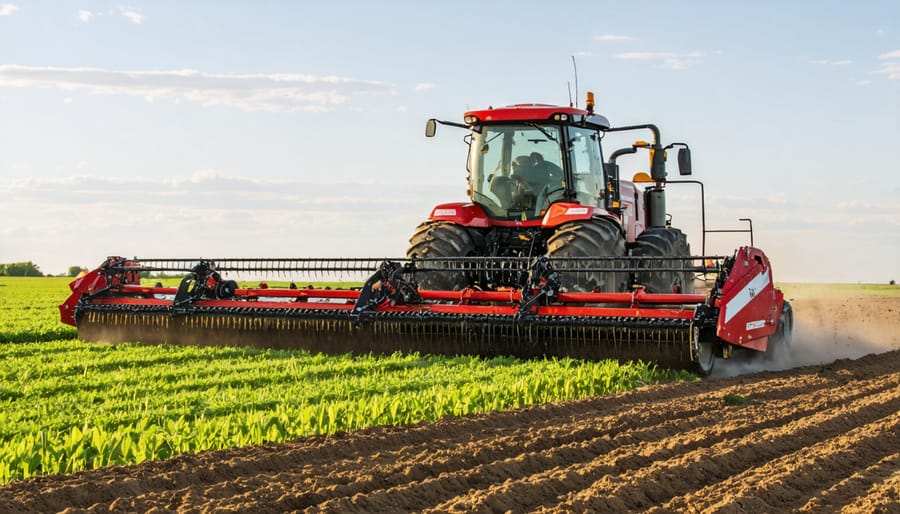
Cover Cropping Strategies
Cover crops play a vital role in enhancing carbon sequestration potential on Alberta farms. Selecting the right cover crops for our climate is crucial – hardy species like fall rye, winter wheat, and hairy vetch have proven particularly effective in our growing conditions. These crops protect soil during vulnerable periods while building organic matter below ground.
For maximum carbon storage, consider implementing a diverse mix of cover crops. Deep-rooted species like tillage radish create channels that help move carbon deeper into the soil profile, while legumes like field peas contribute additional nitrogen while sequestering carbon. Many Alberta farmers have found success with cocktail mixes that combine 3-4 complementary species.
Timing is everything when it comes to cover cropping. Plant winter-hardy varieties in late August or early September to ensure good establishment before freeze-up. For spring-seeded covers, aim to plant as soon as soil conditions permit. Remember to terminate covers at the right stage – usually early flowering provides the optimal balance between biomass production and manageable residue.
Consider your regular crop rotation when selecting cover crops. Choose species that won’t create pest or disease issues for your cash crops. Many producers have successfully integrated cover crops between traditional wheat-canola rotations.
Crop Rotation Benefits
Strategic crop rotation is one of the most effective ways Alberta farmers can enhance carbon sequestration in their soils. By alternating between deep-rooted crops like alfalfa and canola with shallow-rooted crops such as wheat and barley, you create diverse root systems that maximize carbon storage at different soil depths.
A well-planned three to four-year rotation typically includes a pulse crop like peas or lentils, which naturally fix nitrogen in the soil while contributing to carbon storage. Including cover crops during shoulder seasons prevents soil erosion and adds organic matter, further boosting carbon sequestration potential.
Research from Alberta Agriculture shows that farms implementing strategic crop rotations can increase soil organic carbon by 10-15% over five years. Local success stories, like the Morrison Farm near Red Deer, demonstrate how rotating canola, wheat, and field peas has improved both soil health and crop yields while storing an estimated additional 2 tonnes of carbon per hectare annually.
Remember to maintain detailed records of your rotation patterns – this documentation may be valuable for carbon credit programs while helping you track improvements in soil health over time.
Organic Matter Management
Effective organic matter management is key to successful carbon sequestration in Alberta soils. Start by implementing crop rotation practices that include deep-rooted perennial crops and cover crops, which naturally increase soil organic carbon levels. Adding composted manure or crop residues can boost organic matter content while improving soil structure.
Conservation tillage practices, particularly no-till farming, help preserve existing organic matter and promote carbon accumulation. Many Alberta farmers have found success by leaving at least 30% of crop residue on their fields after harvest, protecting the soil and allowing natural decomposition to occur.
Consider incorporating green manure crops like clover or alfalfa, which can be plowed under to add nutrients and organic matter to your soil. Local success stories show that farmers using these methods have increased their soil organic matter by 1-2% over five years.
Biochar application is gaining attention as an innovative approach, with several Alberta farms reporting improved soil health and increased carbon storage after incorporating this stable form of organic matter. Remember to regularly monitor your soil’s organic matter content through testing to track your progress and adjust management strategies accordingly.
Economic Benefits and Incentives
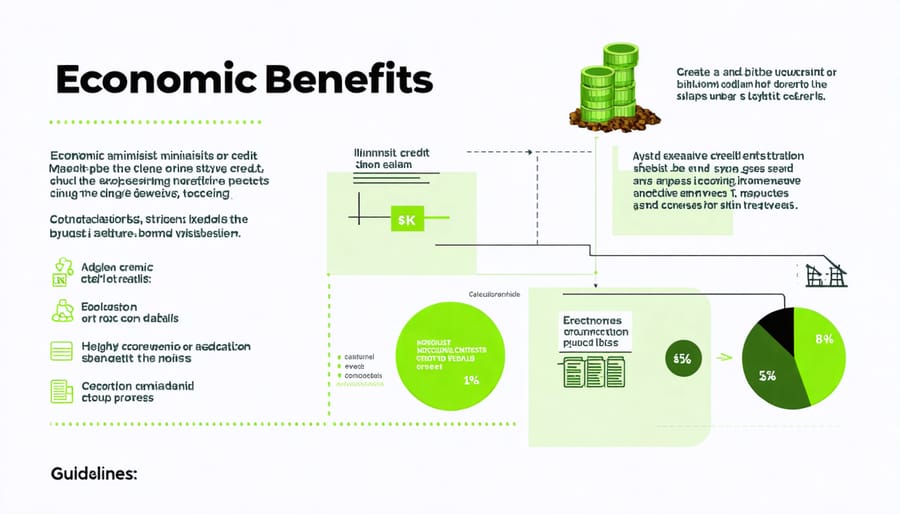
Carbon Credit Programs in Alberta
Alberta leads Canada in agricultural carbon credit initiatives, offering farmers multiple pathways to earn income through carbon sequestration practices. The province’s soil carbon credit opportunities are among the most well-established in North America, with programs designed specifically for our unique agricultural landscape.
The Conservation Cropping Protocol allows farmers to earn credits for implementing reduced tillage practices, while the Enhanced Efficiency Fertilizers Protocol rewards the adoption of advanced fertilizer management strategies. Farmers can earn approximately $15 to $30 per hectare annually through these programs, depending on their specific practices and verification results.
To participate, farmers must first establish a baseline measurement of their soil carbon levels and document their current practices. Annual verification is required, and credits are awarded based on the additional carbon sequestered compared to conventional farming methods. Local aggregators help simplify the process by bundling credits from multiple farms and handling the administrative requirements.
The Agricultural Carbon Coalition, a farmer-led organization, provides support and guidance throughout the application process. They offer workshops and one-on-one consultations to help producers understand program requirements and maximize their carbon credit potential while maintaining productive farming operations.
Long-term Cost Savings
The economic benefits of carbon sequestration extend far beyond immediate carbon credit payments. When soil health improves through sequestration practices, farmers typically see significant cost reductions across multiple aspects of their operations. Many Alberta farmers report up to 30% decrease in fertilizer costs within three to five years of implementing carbon-friendly practices, thanks to improved nutrient cycling and organic matter content.
Water management costs also decrease substantially. Healthy soils with higher organic carbon content can retain up to 20 times their weight in water, reducing irrigation needs and providing resilience during dry periods. This improved water retention can save farmers an average of $30-50 per hectare in irrigation costs annually.
Equipment and fuel costs often decrease as well. Reduced tillage practices mean fewer passes over fields, leading to lower fuel consumption and less wear on machinery. Several case studies from central Alberta show fuel savings of 40-60% after transitioning to minimal tillage systems.
The soil’s enhanced fertility also supports more consistent crop yields, providing greater financial stability. Local success stories, like the Morrison family farm near Red Deer, demonstrate how initial investments in carbon sequestration practices paid for themselves within four years through reduced input costs and improved yield consistency.
These long-term savings compound over time, creating a more resilient and profitable farming operation while contributing to environmental sustainability.
Real Success Stories from Alberta Farms
The Larson family farm in Stettler County has become a shining example of successful soil management practices in Alberta. After implementing no-till farming and cover cropping five years ago, they’ve measured a 15% increase in soil organic carbon and report significantly improved water retention across their 2,000-hectare operation.
In Lethbridge County, Sarah Martinez transformed her traditional grain farm by introducing rotational grazing and diverse crop rotations. Within three years, soil tests showed a 20% increase in carbon content, while her input costs decreased by 30%. “The soil just keeps getting better,” Martinez notes. “We’re using less fertilizer each year, and our yields have actually improved.”
The Berg Brothers near Red Deer demonstrate how legacy farms can embrace change. Their implementation of perennial crops and agroforestry practices has sequestered an estimated 2.5 tonnes of carbon per hectare annually. They’ve also participated in Alberta’s carbon offset program, generating additional revenue while building soil health.
Perhaps most inspiring is the story of the Prairie Collective, a group of six neighboring farms near Grande Prairie. By sharing resources and knowledge, they’ve created a comprehensive carbon sequestration strategy across 8,000 hectares. Their collaborative approach includes intercropping, strategic composting, and precision agriculture. After four years, they’ve documented an average 25% increase in soil organic matter and reduced fuel consumption by 40%.
These success stories showcase how Alberta farmers are leading the way in carbon sequestration while maintaining profitable operations. Their experiences prove that environmental stewardship and agricultural productivity can work hand in hand, creating a sustainable future for Prairie agriculture.
Carbon sequestration presents a significant opportunity for Alberta farmers to contribute to climate change mitigation while potentially improving their soil health and farm profitability. As we’ve explored throughout this article, implementing carbon sequestration practices like no-till farming, cover cropping, and rotational grazing can lead to multiple benefits for your agricultural operation.
The success stories from fellow Alberta farmers demonstrate that these practices are not just theoretical concepts but proven strategies that work in our unique climate and soil conditions. By starting with small changes and gradually expanding your carbon sequestration efforts, you can develop a sustainable approach that suits your farm’s specific needs.
Remember that financial support is available through various provincial programs and carbon credit markets. The key is to document your practices carefully and connect with local agricultural extension services for guidance and support.
Moving forward, consider these next steps:
– Assess your current farming practices and identify areas where you can implement carbon sequestration techniques
– Connect with your local agricultural advisor to develop a tailored implementation plan
– Join farmer networks and discussion groups to share experiences and learn from others
– Start monitoring and recording your soil carbon levels to track progress
– Explore available funding opportunities and carbon credit programs
By embracing carbon sequestration practices, you’re not just investing in environmental sustainability – you’re investing in the future of your farm and Alberta’s agricultural legacy.

